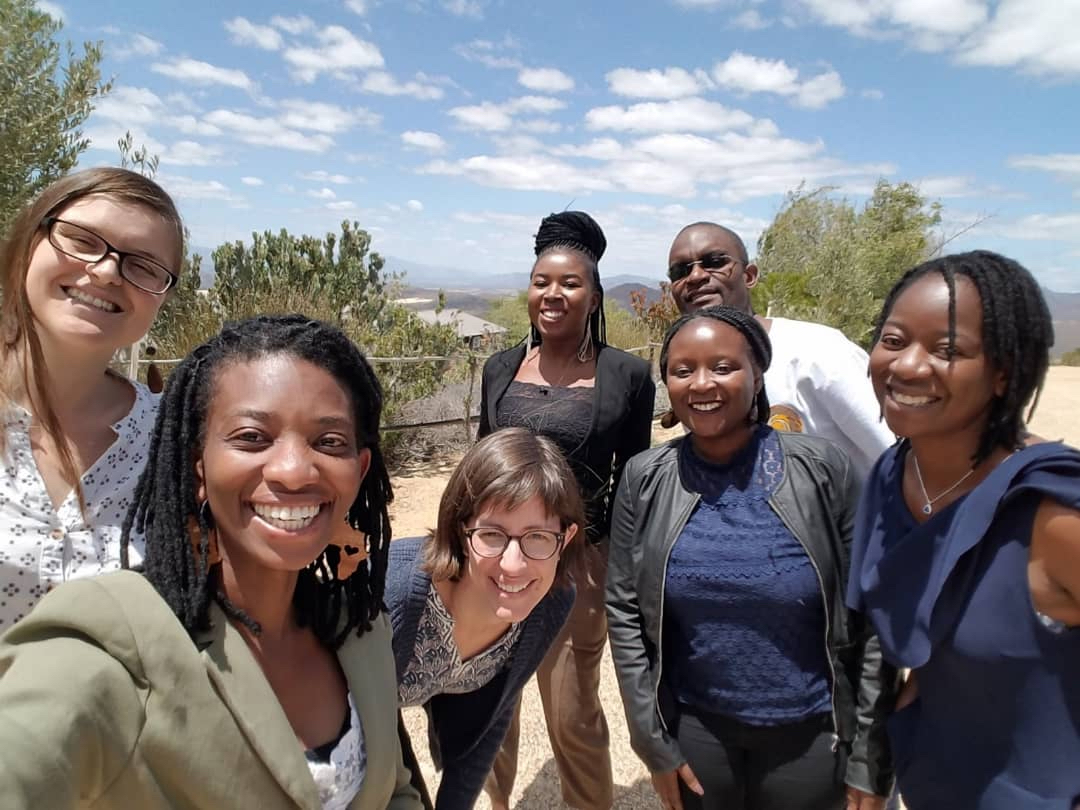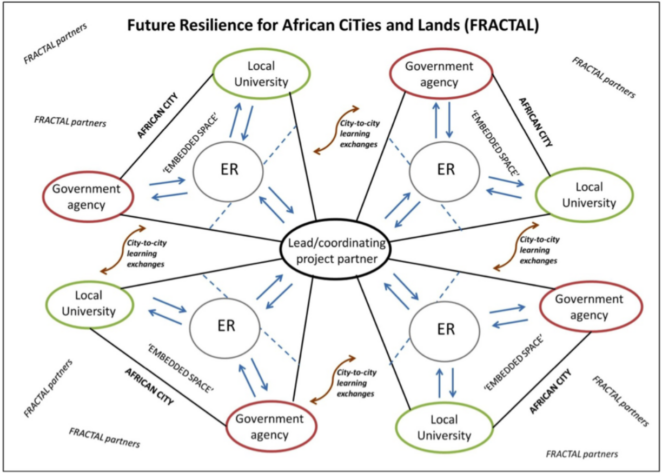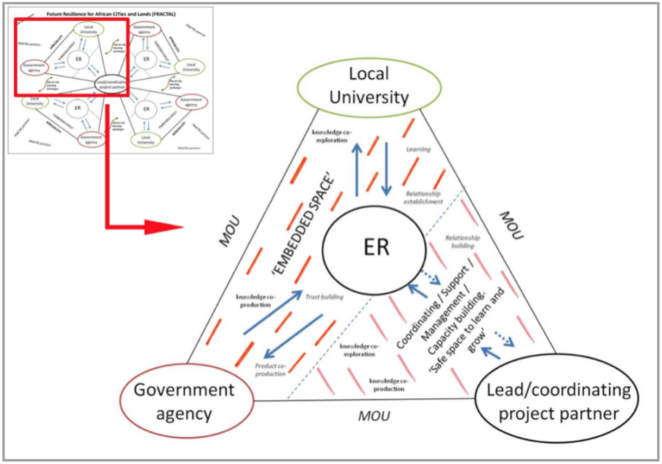An Embedded Researcher approach to integrate climate information into decision making in southern African cities: lessons from FRACTAL

Summary
Building the climate resilience of African cities is a complex challenge that requires knowledge, policy and practice to be brought closer together to shape research and actions. One way of doing so is to establish intermediaries to work between academia and government. Within the Future Resilience for African Cities and Lands (FRACTAL) project we used the model of Embedded Researchers (ERs) – individuals employed by the university in each city to work part of their time within the city government to identify and implement a collaborative research (or knowledge co-production) agenda.
The Working Paper discusses the intricacies of these arrangements, their benefits and challenges, and the lessons learnt. With certain enabling conditions, the ER approach has proven to be an effective means of bringing the worlds of climate science and urban decision-making closer together in the pursuit of building more climate resilient cities. The findings indicate that the approach is transferable to other contexts and other problem spaces. The ER approach goes beyond a focus on what knowledge is needed, in the FRACTAL case to act on climate risks and vulnerabilities in cities, to attend to how knowledge is generated and who is involved. The ER approach contributes to making both academic research and public decision-making more legible and thereby more accessible and accountable.
A case study where embedded researchers were used to develop a common language for climate change by reducing ambiguities in terminology used in the climate space can be found here.
START have created a podcast focussing on the implementation and lessons learnt from the FRACTAL project. Access the podcast here.
*Download the full working paper from the right hand column. The key messages from the report are provided below. See the full text for much more detail.
Introduction
There is often a disconnection or gap between scientific knowledge and the implementation of actions aimed at addressing related problems. Making science, or the structured pursuit of improved knowledge, more inclusive is important because the knowledge sought is more reflective of priorities widely-held in society and the products of research are more widely understood and thereby more readily able to be acted upon.
Taking a transdisciplinary approach to co-producing actionable knowledge between multiple actors can help build the climate resilience of African cities. Read more about the principles of transdisciplinarity, co-production, and co-exploration here. One of the key challenges in implementing this approach is building enough trust, familiarity and understanding across various boundaries.
This FRACTAL project employed several strategies to address this challenge – one of which is the establishment of embedded researchers (ERs).
The text below provides an overview of the method, challenges and lessons learnt from this project. See the full text for more detail.
Embedded Researchers

Embedded researchers are individuals or teams who are employed by a research institution and are deployed to work (part of their time) within a host organisation with the purpose of identifying and implementing a collaborative research agenda. An embedded researcher can increase research impact – even in domains of high uncertainty – by spending an intensive period enmeshed in the culture and operations of other work communities.
The embedded experience can range from conducting highly structured research to being a casual participant-observer in another community. It gives scientists opportunities to build personal relationships, facilitate the spread of new ideas, and learn the constraints and initiatives specific to a particular organisation or community. This may improve the impact of research on policy and practice, as well as shaping the research agenda based on knowledge needs within the policy and practitioner communities.

Outcomes and Impacts
The FRACTAL ER approach has focused on early career researchers and professionals, within the first 10 years of their careers, with the aim of building their capacity to undertake collaborative and impactful research on climate-related issues that is guided by and feeds directly into urban policy and -practice. For the individual ERs, numerous skills and benefits have been accrued through their involvement in FRACTAL (see Working Paper for the list of individual benefits).
With the initiative and support of FRACTAL the ERs create opportunities to connect with and connect up a diversity of people, projects, information and knowledge across organizations, cities, sectors and scales. The ERs have a pivotal role in establishing, facilitating and sustaining a variety of co-exploration and co-development platforms, approaches and networks. Benefitting from their integral involvement and hands-on approach, a range of professional and personal learning opportunities for those involved in the project (direct or peripheral) were unlocked through the FRACTAL project (see list in Working Paper).
Across the cities there are signs of the ERs and FRACTAL as a whole adding value beyond only the individuals and organizations directly involved to the wider city context. These outcomes are more extensively documented in the FRACTAL impact stories. It is difficult to anticipate what the knock-on effects of all these activities, interactions, learning opportunities and outputs will be, but they have created fertile ground for progressing the climate agenda within and between the cities and others in the southern African region. While these developments cannot be solely attributed to the ERs, the persistence and skills of the ERs in building relationships, opening and sustaining communication across organizations, disciplines and sectors, and translating relevant information, needs and opportunities clearly played a key role.
Barriers
- Being an anomaly and a hybrid – There are several challenges that emerge from operating across two domains: being a researcher in a public policy and operational public service environment and being a highly applied person in a largely natural sciences research environment.
- Competing logics and demands – It is challenging to merge and comply with the different codes of conduct and expectations from the two different organisations.
- Working beyond one’s discipline of profession – The technical nature of biophysical climate information and the conceptual complexity of understanding city regional systems, governance arrangements and notions of transdisciplinarity proved challenging for many, including the ERs.
- Dynamic and constrained organizational environment – Influential people are usually in high demand, especially in under-resourced and under-staffed settings, so access to and commitment from them is not easily obtained by the ER.
Lessons Learnt
- Considerable time needs to be given to the startup phase of negotiating a shared problem space and getting the organizational partnership agreements and contracts in place to enable the recruitment of an ER.
- Both organizations must be open to some innovation and change to be able to get full value out of an ER arrangement. ERs can be part of opening up spaces and producing outputs, but only if the organizations they are operating in create an enabling environment to do so.
- ERs need to have excellent interpersonal, communication and organizational skills, a willingness to be outside of their comfort zones, a strong desire to learn and an ability to be reflexive.
- ERs can learn more and work more effectively if they are networked with other ERs and are well supported by supervisors and project coordinators. The role is novel and unfamiliar to most so it requires considerable negotiation and learning through trial-and-error.
- The success and impact of the ERs work is based on balancing between a clear scope of work relating to the shared problem space and a level of flexibility that enables emergent, unforeseen opportunities to be leveraged.
- New metrics and forms of assessing performance are needed to account for the hybrid role that ERs play. These need to capture the building of trust, relationships, understanding and collaboration, as much as measuring substantive outputs.
- ERs cannot achieve the ultimate objectives of increasing the evidence base of policy-making and planning and the relevance of research without a network of internal champions in government and academia that create windows of opportunity for change within ongoing policy, planning and research processes. Often the ‘glue’ or ties that bind such networks are a common or shared question, problem or objective that cannot be addressed in isolation within a single department, sector or profession.
Suggested Citation
Pretorius, L., Taylor, A., N Lipinge, K., Mwalukanga, B., Mucavele, H., Mamombe, R., Zenda, S. and McClure, A. (2019). An Embedded Researcher approach to integrate climate information into decision making in southern African cities: lessons from FRACTAL. Future Resilience for African CiTies and Lands (FRACTAL).
(0) Comments
There is no content